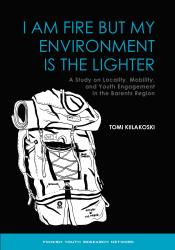I am Fire but my Environment is the Lighter: A Study on Locality, Mobility, and Youth Engagement in the Barents Region

Nyckelord:
youth, youth culture, living environment, locality, mobility, Barents region, Finland, Norway, Russia, young people, everyday lifeSynopsis
The purpose of this study is to provide an insight into how the youth of the Barents Region view their lives and to analyse the implications of these experiences for youth policy. The study focuses upon three locations in the very north of the Barents Regions in Inari, Finland, Alta, Norway, and Murmansk, Russia.
The methodology of the research was to examine pieces of artwork done by young people. The data consisted of drawings, photographs, songs, and research interviews. The aim was to use artistic methods to explore the conditions, youth cultures, and daily life situations of the young residents. Accordingly, the research was both qualitative and participatory – the respondents were free to choose the themes they wanted to tackle and the art form with which to do so. The theoretical concepts that were used to analyse the data were space/place, mobility, and engagement.
The youth of the Barents Region emphasise the importance of nature and home. Their relation to nature is multifaceted, such as: traditional livelihoods, human-animal interactions with reindeers, hunting, hiking, jogging, or riding snowmobiles. Nature becomes a meaningful part of everyday life. Additionally, nature is strongly connected to peer activities as it offers opportunities to be outside adult supervision. Furthermore, through media the youth in the Barents region are a part of global youth cultures. These results are in contrast with studies of urban young and youth cultures. A study emphasises when studying young people from outside urban centres, the different relationships to the environment cannot be analysed using the denaturalised categories of urban youth cultures.
Mobility in the Barents region is both a possibility and a social imperative. According to the results, the issue of mobility involves overcoming large geographical distances, facing the youth cultural distances, coming to terms with peers leaving (and thus addressing the temporality of social ties and learning to leave oneself. Furthermore, the this study found that youth should be able to face the temporality of their social ties and even their own living in the region. Due to the mobility imperative they should be able to make a transition to other locations and can live a good life there. There is a dual task of learning to leave and to be mobile, whilst at the same time learning to understand the value of their surroundings and community.



